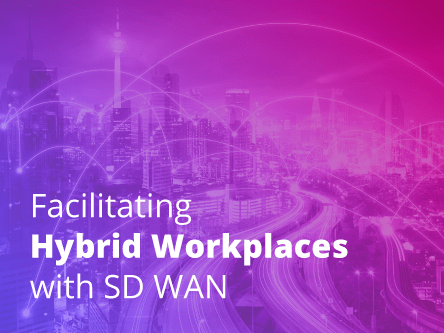In this article we will explain what a Software Defined Wide Area Network (SD WAN) architecture is and describe its 4 technical components. Discover whether a managed global SD WAN network is the right connectivity solution for your IT business.
What Is SD WAN Architecture?
SD WAN networks are immensely popular as they can be deployed rapidly everywhere and run on any connectivity infrastructure, including fixed broadband, leased lines, fibre and even mobile data connections.
The architecture of SD WAN enables rapid site deployment and interconnection of any site, to any location, application, or cloud platform. This makes SD WAN a flexible and resilient network connectivity solution.
What Are The 4 Components of SD WAN?
The architecture of SD WAN consists of 4 unique building blocks: data, control, management, and orchestration.
The data block is responsible for the actual sending and receiving of data. The wide area network devices receive and execute the directions as set forth by the control block.
The control block’s main task is to control secure gateways between all nodes in the network and send the routing and security protocols to the network devices in the data block.
In the management block, the entire SD WAN network can be monitored and controlled by the authorised users. It also collects statistics about the network and can generate alerts in regard to service and performance interruptions.
The orchestration block oversees all automation of the SD WAN network. Anything related to provisioning and authentication is managed by this domain in the SD WAN architecture.
Where Can SD WAN Architecture Be Deployed?
Customers who wish to deploy SD WAN architecture can do this in 3 distinct locations. They may deploy the SD WAN architecture on-premises, for example with dedicated networking equipment in their own office or data centre location.
A second option to deploy SD WAN architecture could be in the cloud. Here, customers can connect virtual machines provided by a cloud provider, to connect physical sites and SD WAN users to a cloud platform.
A third option to deploy SD WAN architecture is a combination between cloud and a network backbone. This means building SD WAN infrastructure both in a cloud and in between cloud providers, using the private network backbone to interconnect these cloud providers.
Types of SD WAN Architecture Deployments (PoPs)
Customers can build and use SD WAN networks in multiple ways. They can build their own SD WAN network with dedicated hardware, which keeps them in full control of their network at all times.
Customers can also use SD WAN services from a managed services provider (MSP), where they will build the SD WAN network based on the requirements of a customer. The MSP offers this network as a managed IT service for a monthly recurring service fee.
A third option is a managed SD WAN from a cloud provider. The customer can use a global network of SD WAN PoPs and infrastructure that is already in place to rapidly deploy and start using services based on their actual demand.
The Business Case for SD WAN – Getting Started
To determine if there is a business case for SD WAN in your business, it is important to look at your overall IT strategy and cloud adoption.
Is your business primarily using a centralised IT environment, where corporate data, applications and network security are managed from a central data centre? In such case, SD WAN may not be the best fit for your organisation.
If your business is already using cloud applications and services and has a decentralised IT-structure, then your end-users will benefit the most from an SD WAN architecture that includes security integration.
Epsilon is a global connectivity provider that can provide managed SD WAN services and implement SD WAN on-demand worldwide. Contact Epsilon today to see how our global performance network of PoPs, SD WAN architecture and network coverage can help accelerate your IT business.







